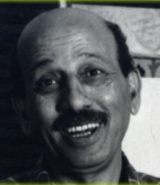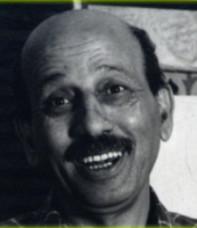
Abed Abdi
Encyclopedia

Abdi worked as a blacksmith
Blacksmith
A blacksmith is a person who creates objects from wrought iron or steel by forging the metal; that is, by using tools to hammer, bend, and cut...
and illustrated Arabic
Arabic language
Arabic is a name applied to the descendants of the Classical Arabic language of the 6th century AD, used most prominently in the Quran, the Islamic Holy Book...
publications that appeared in Israel. After studying in Dresden, Abdi became the first Palestinian to build monumental art on native soil. His allegorical monuments in Galilee, honoring human fortitude and resistance, include a narrative mural depicting Elijah¡s defiance and survival and a bronze
Bronze
Bronze is a metal alloy consisting primarily of copper, usually with tin as the main additive. It is hard and brittle, and it was particularly significant in antiquity, so much so that the Bronze Age was named after the metal...
monument dedicated to six Palestinians who were shot on Land Day
Land Day
Land Day , March 30, is an annual day of commemoration for Palestinians of the events of that date in 1976. In response to the Israeli government's announcement of a plan to expropriate thousands of dunams of land for "security and settlement purposes", a general strike and marches were organized...
.
Abdi Held his first exhibition in Tel-Aviv in 1962. He then pursued academic studies at the Fine Arts Academy in Dresden
Dresden
Dresden is the capital city of the Free State of Saxony in Germany. It is situated in a valley on the River Elbe, near the Czech border. The Dresden conurbation is part of the Saxon Triangle metropolitan area....
(Germany). His professors were L.Grundig, G. Bondzin and G. Kettner. His masterwork at the Academy received the 2nd prize, which allowed Abdi to spend another year at the Academy and specialize in mural
Mural
A mural is any piece of artwork painted or applied directly on a wall, ceiling or other large permanent surface. A particularly distinguishing characteristic of mural painting is that the architectural elements of the given space are harmoniously incorporated into the picture.-History:Murals of...
s and environmental sculpture
Environmental sculpture
The term environmental sculpture is variously defined. A development of the art of the 20th century, environmental sculpture usually creates or alters the environment for the viewer, as opposed to presenting itself figurally or monumentally before the viewer...
.
In 1972 he returned to Haifa, and worked as graphic designer for a number of Arabic language publications, taught arts and designed murals. The city of Haifa awarded Abdi the "Herman Struck Best Artist of the Year" Prize in 1973. That year, he also obtained the Young Artist's award at the Berlin International Youth Festival. The city of Haifa awarded him the "Best Artist of the Year Hermann Struck" award for the second time in 1999.
Abed Abdi has erected a number of memorial monuments and murals: in 1976—a sculpture to commemorate Land Day; in 1984—the memorial to commemorate 75 years for the existence of the Galilean municipality of Shefa Amr. In addition, he has painted a number of murals in Haifa, Jaffa and Nazareth.
Abed Abdi has exhibited in Qatar, Israel, Belgium and Bulgaria. He has participated in over 45 group exhibitions, among them the joint Palestinian-Israeli exhibition "It's possible" which toured the US and Germany between 1988 and 1990. In 1995 he participated in the second exhibition for Palestinians and Israelis in Germany. His work appeared in the "Solidarity with the Palestinian People" exhibit in Tokyo, Berlin, Brussels, Belgrade and Athens. He also organized and participated in exhibitions with Israeli and Palestinian artists in Tel-Aviv, Haifa and West Jerusalem in the period between 1980 and 1987 defending the freedom of expression and creativity.
Abdi is an active member of the Haifa branch of the Israeli Association of Painters and Sculpturers, as well as the Jewish-Arab Center of Beit Hagefen. This has enabled him to unite Palestinian and Israeli artists, and organize joint exhibitions, bringing the prospects of peace closer. Abdi founded the Ibda' society for the promotion of visual arts in the Arab Israeli sector and Arabelle - Visual Arts Workshop in Haifa, for the promotion of the visual arts and intercultural dialogue through the arts. Abdi is president of Al Midan Theater in Hafia. He has been teaching fine arts in the Arab Pedagogical College in Haifa since 1985.

